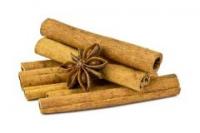Botanical Family: Lauraceae (laurel)
Plant Origin: Sri Lanka, Madagascar, Ceylon
Extraction Method: Steam distilled from bark
Key Constituents: Trans-Cinnamaldehyde (40-50%), Eugenol (20-30%), Beta-Caryophyllene (3-8%), Linalol (3-7%)
ORAC: 10,340 mTE/100g
Historical Data: Listed in Dioscorides’ De Materia Medica (A.D. 78), Europe’s first authoritive guide to medicines, which became the standard reference work for herbal treatments for over 1,700 years.
Cinnamon was reputed to be part of the “Marseilles Vinegar” or “ Four Thieves Vinergar” used by grave-robbing bandits to protect themselves during the 15th century plague.
Medical Properties: Anti-inflammatory (COX-2 inhibitor), powerfully antibacterial, antiviral, antifungal, anticoagulant, circulatory stimulant, stomach protectant (ulcers), antiparasitic (worms)
USES: Cardiovascular disease, infectious diseases, viral infections (Herpes, etc.), digestive complaints, ulcers, and warts
Fragrant Influence: Thought to attract wealth
Application: : Dilute 1 part essential oil with 4 parts V-6 Vegetable Oil Complex or other pure vegetable oil; (1) apply 1-2 drops on location, (2) apply on chakras and/or Vita Flex points, (3) diffuse, or (4)take as dietary supplement.
Caution: May irritate the nasal membranes if inhale directly from diffuser or bottle.
Found in: Abundance, Carbozyme, Christmas Spirit, Egyptian Gold, Exodus II, Highest Potential, Thieves.
|
|

